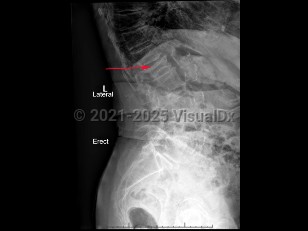Classic history and presentation: OVCF can present with acute, localized spine pain that infrequently radiates to the ribs. Pain worsens with movement and palpation. However, two-thirds of OVCF are asymptomatic and found incidentally on lateral chest x-ray or with loss of the patient's height.
Although generally not life-threatening, OVCF of the spine may cause functional impairment due to acute pain or chronic kyphotic deformity.
Prevalence: Approximately 700 000 cases are seen in the United States annually.
- Age – More prevalent with increasing age.
- Sex / gender – More prevalent in women, particularly those who are postmenopausal.
Pathophysiology: Osteoporosis is characterized by normal bone quality but low bone density with thinned cortices and decreased cancellous trabecular continuity. The structural integrity of the bone is diminished, and risk of fracture is increased. OVCF occurs when compressive forces are greater than the weakened bone(s) can withstand.
Grade / classification system: The Genant classification of vertebral fractures is based on morphology of the vertebral body (eg, wedge, biconcave, or crush deformities) and grades the severity of fracture.
- Grade 0 (normal): No vertebral height loss seen
- Grade 1 (mild fracture): 20%-25% vertebral height loss
- Grade 2 (moderate fracture): 25%-40% vertebral height loss
- Grade 3 (severe fracture): > 40% vertebral height loss


